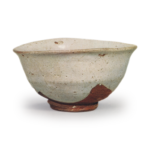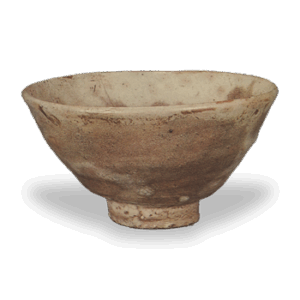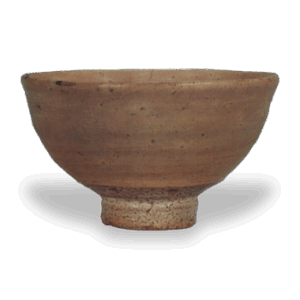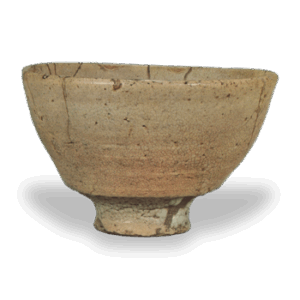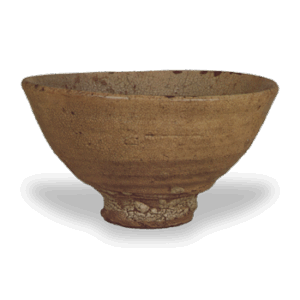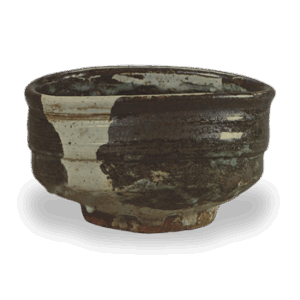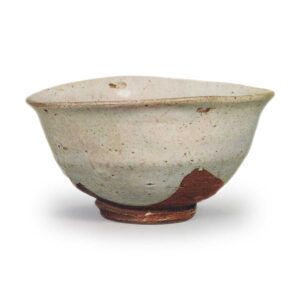
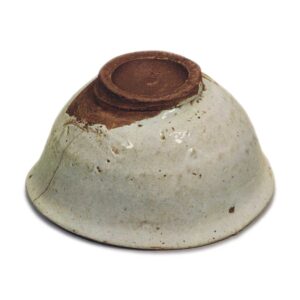
Choko Meibutsu
Important cultural property
Nezu Museum
Height: 7.0-8.0cm
Diameter: 13.4-14.7cm
Outer diameter of foot ring: 5.5cm
Height of foot ring: 1.0cm
This tea bowl is particularly famous among hard-paste wares, and is named after the fact that it was owned by the Kyoto physician Nagasaki Shosai (Kudayu). It was later cherished by Kobori Enshu, and became a famous tea bowl.
The clay is hard and of a quality that is suitable for making tea bowls, and the bowl is solid and heavy to the touch, but the workmanship is completely earthenware-like, with a light and casual finish that exudes a deep sense of tea. The bowl is slightly thick, with a deep lip and a rough lathe mark around the body, and the foot is thin and strong, with a bamboo-like knot and a round indentation in the center. The slightly distorted shape of the light and elegant molding also adds to the charm of the piece. The free style of this rare piece is a major characteristic of Nagasaki ware.
The glaze is a light blue-white, and the base is unglazed clay, with variations in the way the glaze breaks, creating a strong bamboo-jointed foot. There are creases in the bottom caused by scraping. There is a mirror-like crack in the middle, three eyes, and a horizontal crack in the middle of the body. There are also cracks from the rim to the body.
Many of the hard-paste tea bowls that are prized as works of art are thought to have been produced at the Kinkai Kiln, and it is safe to assume that the one from the Sakai family collection is also from this kiln. The Gosomaru tea bowl that follows is also from the Kinkai Kiln, and judging from the glaze, it is thought to be from around the same period as the one from the Sakai family collection. The thin-walled so-called Kinkai tea bowls were made a little later, in the early Edo period. The old Kante ware is soft to the touch and has a thick, soft glaze, but as time goes on, the clay becomes firmer and harder, the tea bowl becomes heavier to the touch, and the glaze becomes thinner. This trend can also be seen in the Kinkai Kante Gosomaru tea bowls.
Kagami-ochi is also called kagami, and refers to a circular depression in the center of the piece. In Kumagawa and Tamagote, the presence of this depression is a defining characteristic. This type of depression is also commonly seen in katate, and of course it is based on the use of kote in the design, but the fact that all of these techniques are from the Gyeongsangnam-do region shows that there are also commonalities in the details of the techniques. The round-edged inside of the Nagasaki Takadai is common to that of the Kumagawa and Tamagote, but it also reminds us of that of the Okokamata of the old Karatsu, and is very interesting.
Inner box, lid, inscription on the front: Kobori Enshu “Nagasaki
Outer box, lid, inscription on the front: Matsudaira Fumai ”Nagasaki Kente
It was originally owned by Nagasaki Shosai, and later became the treasured possession of Kobori Enshu, but when Kobori Daizen came into power, he donated it to the Kotobuki-an temple of the Daitoku-ji sect, and it has been a treasured item of the temple ever since. In the Tenmei era, Matsudaira Fumai, the lord of the Matsue domain in Unshu, requested the abbot of Kobōan, Taikai, to acquire it for him, and he was given it for 400 ryō. It has been in the possession of the same family ever since, but in modern times, Nezu Aoyama (Kaichirō) asked the Matsudaira family to keep it as a secret treasure, and in 1941, when the Nezu Museum was established, it became part of the museum’s collection and has remained there to the present day.

